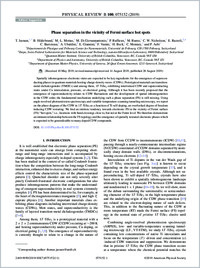Phase separation in the vicinity of Fermi surface hot spots
- Jaouen, Thomas Département de Physique and Fribourg Center for Nanomaterials, Université de Fribourg, Switzerland
- Hildebrand, Baptiste Département de Physique and Fribourg Center for Nanomaterials, Université de Fribourg, Switzerland
- Mottas, Marie-Laure Département de Physique and Fribourg Center for Nanomaterials, Université de Fribourg, Switzerland
- Giovannantonio, M. Di Empa, Swiss Federal Laboratories for Materials Science and Technology, nanotech@surfaces Laboratory, Dübendorf, Switzerland
- Ruffieux, Pascal Empa, Swiss Federal Laboratories for Materials Science and Technology, nanotech@surfaces Laboratory, Dübendorf, Switzerland
- Rumo, Maxime Département de Physique and Fribourg Center for Nanomaterials, Université de Fribourg, Switzerland
- Nicholson, Christopher W. Département de Physique and Fribourg Center for Nanomaterials, Université de Fribourg, Switzerland
- Razzoli, Elia Quantum Matter Institute, University of British Columbia, Vancouver, Canada - Department of Physics and Astronomy, University of British Columbia, Vancouver, Canada
- Barreteau, C. Department of Quantum Matter Physics, University of Geneva, Switzerland
- Ubaldini, A. Department of Quantum Matter Physics, University of Geneva, Switzerland
- Giannini, E. Department of Quantum Matter Physics, University of Geneva, Switzerland
- Vanini, Fabiano Département de Physique and Fribourg Center for Nanomaterials, Université de Fribourg, Switzerland
- Beck, Hans Département de Physique and Fribourg Center for Nanomaterials, Université de Fribourg, Switzerland
- Monney, Claude Département de Physique and Fribourg Center for Nanomaterials, Université de Fribourg, Switzerland
- Aebi, Philipp Département de Physique and Fribourg Center for Nanomaterials, Université de Fribourg, Switzerland
-
28.08.2019
Published in:
- Physical Review B. - 2019, vol. 100, no. 7, p. 075152
English
Spatially inhomogeneous electronic states are expected to be key ingredients for the emergence of superconducting phases in quantum materials hosting charge-density waves (CDWs). Prototypical materials are transitionmetal dichalcogenides (TMDCs) and among them, 1T-TiSe2 exhibiting intertwined CDW and superconducting states under Cu intercalation, pressure, or electrical gating. Although it has been recently proposed that the emergence of superconductivity relates to CDW fluctuations and the development of spatial inhomogeneities in the CDW order, the fundamental mechanism underlying such a phase separation (PS) is still missing. Using angle- resolved photoemission spectroscopy and variable-temperature scanning tunneling microscopy, we report on the phase diagram of the CDW in 1T-TiSe2 as a function of Ti self-doping, an overlooked degree of freedom inducing CDW texturing. We find an intrinsic tendency towards electronic PS in the vicinity of Fermi surface (FS) “hot spots,” i.e., locations with band crossigs close to, but not at the Fermi level.We therefore demonstrate an intimate relationship between the FS topology and the emergence of spatially textured electronic phases which is expected to be generalizable to many doped CDW compounds
- Faculty
- Faculté des sciences et de médecine
- Department
- Département de Physique
- Language
-
- English
- Classification
- Physics
- License
-
License undefined
- Identifiers
-
- RERO DOC 327462
- DOI 10.1103/PhysRevB.100.075152
- Persistent URL
- https://folia.unifr.ch/unifr/documents/308291
Statistics
Document views: 154
File downloads:
- pdf: 242
